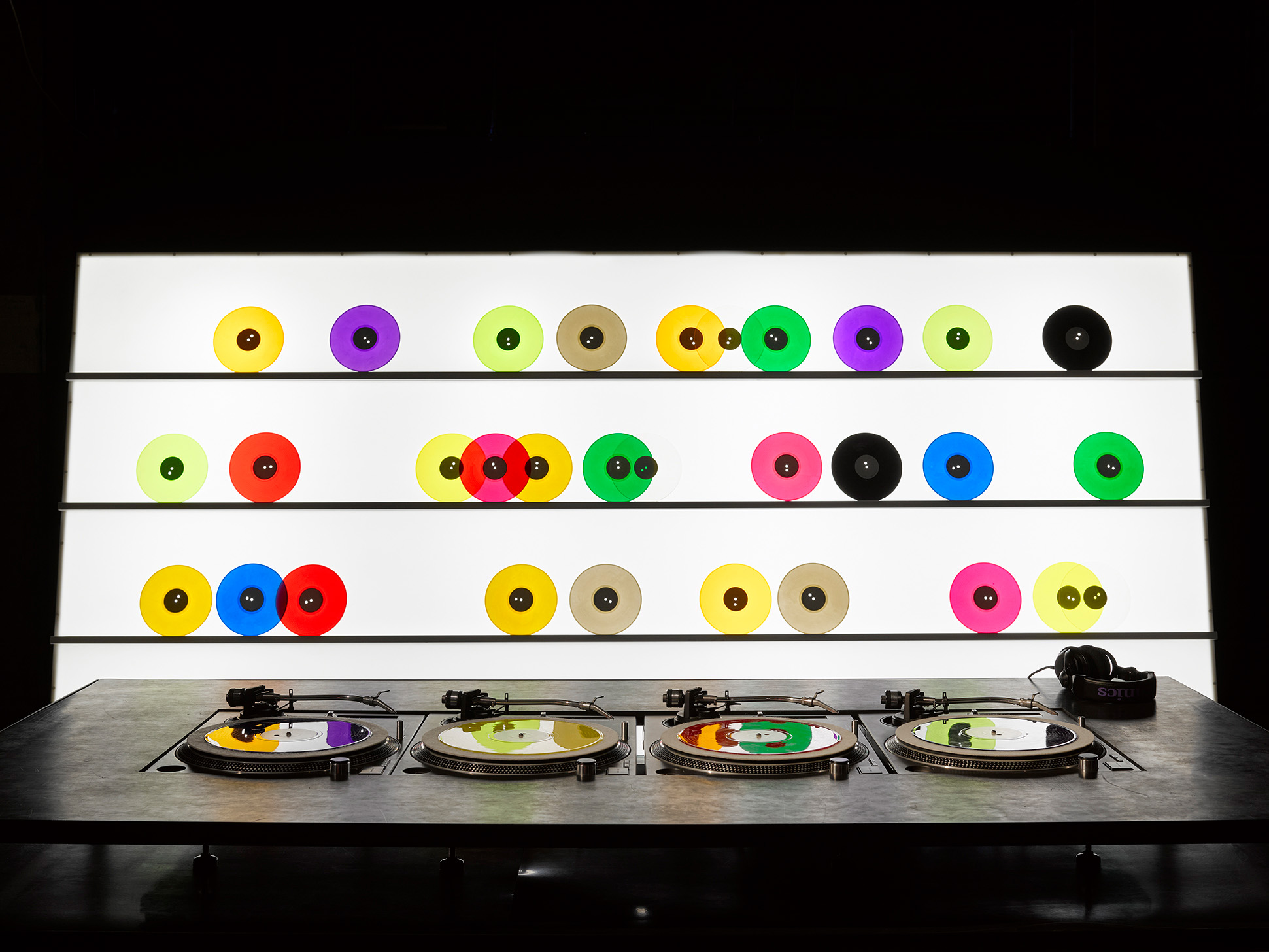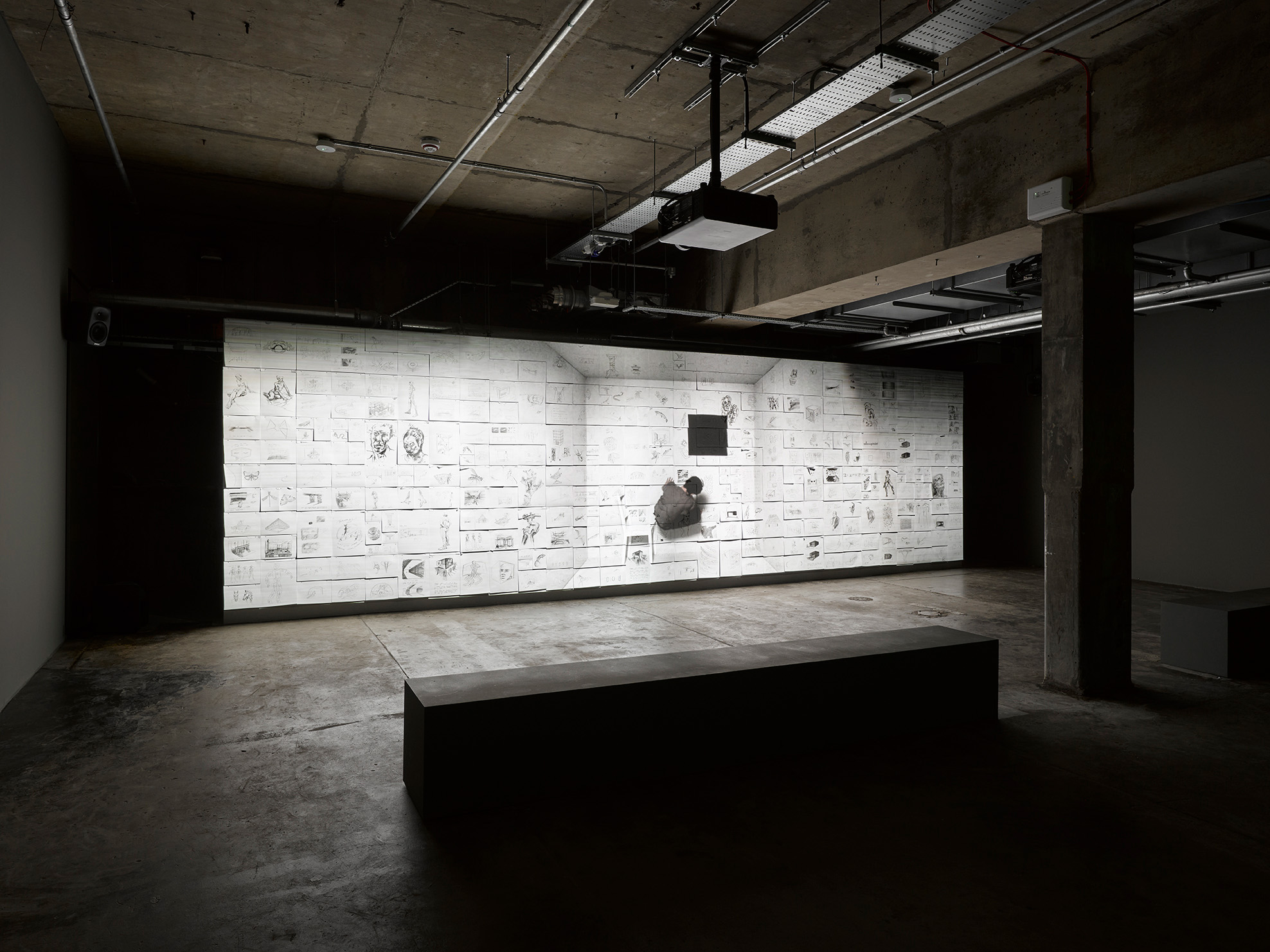Art & music combine in The Vinyl Factory’s immersive
soundscape
In the huge basement of 180 Studios off the Strand, London, The
Vinyl Factory have created an immersive exhibition of art & music. With a
series of large-scale installations & presentations from leading artists
& designers, the exhibition also creates a site for performances &
dialogue over the summer months.
A huge new exhibition with work at the intersection of art
and sound has opened in London’s 180 Studios. After descending a narrow
staircase into the dark, labyrinthine basement space off the Strand, a series
of installations, including new commissions from Theaster Gates, Es Devlin,
Julianknxx, and Caterina Barbierie, as well as several first UK showings for artworks
by others including Stan Douglas, Virgil Abloh, and Carsten Nicolai.
REVERB presents work from over 100 artists and musicians within works made over the last two decades, with a series of live performances and talks also taking place between now and the end of the project in late September. It’s all organised by The Vinyl Factory, who not only mount exhibitions around visual art and sound, but also run a music label and vinyl pressing plant – within the exhibition is a space created by Hacienda-designer Ben Kelly that presents 100 records created by the organisation since 2009 by artists and musicians from Grace Jones (see 00199) and Christian Marclay to Marina Abramovic and Massive Attack.
![]()
![]()
It all starts with a richly textured film by Stan Douglas, projected within a tall concrete hall, a ramped floor offering vantage from rows of soft seating. Luanda-Kinshasa (2013) is a six-hour-long film that can be dropped in and out of for any duration. A simple documentation recording of Columbia Records’ Manhattan 30th Street Studio, where musicians including Glenn Gould, Miles Davis, Manu Dibango, and Bob Dylan recorded. Using Jean Luc Godard’s documentation of the Rolling Stones’ recording Sympathy for the Devil as a visual prompt, Douglas assembled a group of excellent musicians and sound engineer who jam with one another as a coterie of observing journalists, friends, and label employees watching on.
The film is a deep study of the craft, play, and collaboration at the heart of such music making, but is also a compelling study of place. The architecture of the studio is a key protagonist of the film, not just providing backdrop but also a sense of timelessness and vernacular to the art. The sloping ramp leads to a doorway under the projected film, and the start of a long, circular route through a creative soundscape.
Architecture is also central to Cecilia Bengolea’s film Shelly Belly Inna Real Life (2020), a study of Jamaican dancehall music and dancing, but with a choreography played out across the island’s built landscape. The artist presents what she terms ‘animated sculptures’ through dance, performed in a range of urban spaces including a back alley, a suburban cul-de-sac housing development, backyards, and the roof of a mechanics’ garage. It is a film very much from the inside of the groups of musicians and dancers as well as the architectures and spaces from which the culture exists.
![]()
![]()
Virgil Abloh’s 12-inch Voices (2019), made two years before the designer’s untimely passing, is a bright pink explosion of pleasure and celebration of Chicago’s DJ culture and architecture. Abloh studied Architecture at the Illinois Institute of Technology before primarily following his other passion, fashion, with an internship at Fendi where he met and began collaborating with Kanye West. Spiky pink soundproofing foam panels are arranged into a room-filling minimalist sculpture and speaker combined.
Jenn Nkiru’s poetic documentary film Black To Techno (2019) explores the birth of techno music in the factories and architectures of Detroit, following the black history of Motown into techno as an expression of civic hope through a montage of found footage and archive material.
Another Chicago-rooted artist with an interest in architecture is Theaster Gates. Having studied urban planning and ceramics at degree level, Gates’ work is centred on art and craft as a socially engaged form of community building and regeneration of place, with particular focus on African-American communities who have suffered disinvestment since the 2007 economic crash.
For REVERB, Gates has created Amplified (2024), a simple arced stage formed of materials used throughout his regular practice – wood, light, tar, and torch down rubber. It stands as a simple form, acting as a sculpture when empty but on occasion as a space of performance and dialogue across the exhibition’s run. Gates’ own experimental band, the Black Monks, will be performing on the stage, which the artist also deems “an altar, a pulpit, a sacred zone, and an amplifier.”
![]()
![]()
Es Devlin invites a physicality into her work, Screenshare (2024). The artist established her name as a stage designs for a range of clients,
from Trevor Nunn’s National Theatre and Kanye West’s 2005 Touch the Sky tour, to the 2022 Super Bowl halftime show featuring Dr Dre, Kendrick Lamar and
Eminen and the opening commission for Manchester’s Aviva Studios (see 00147).
Over this time, her work has become increasingly architectural in scale, including the commission for Britain’s pavilion at the 2020 Dubai World Expo. Here, the architectural worldbuilding is contained within the 8 minute long HD and digitally-developed film, while a haptic quality is added at the end when the lights come up and reveal the screen to be formed of stacks and stacks of the artist’s notebook sketches – a message invites viewers to step to the front and tear off one of the sketches to keep as memento.
The navigation of videos, sculptures, immersive experiences, and sound is a deeply spatial experience in itself, and the circular route ends back at Stan Douglas’ Luanda-Kinshasa. Now, the ramp takes the visitor out of the soundscape, towards the Strand and into the city.
![]()
![]()
REVERB presents work from over 100 artists and musicians within works made over the last two decades, with a series of live performances and talks also taking place between now and the end of the project in late September. It’s all organised by The Vinyl Factory, who not only mount exhibitions around visual art and sound, but also run a music label and vinyl pressing plant – within the exhibition is a space created by Hacienda-designer Ben Kelly that presents 100 records created by the organisation since 2009 by artists and musicians from Grace Jones (see 00199) and Christian Marclay to Marina Abramovic and Massive Attack.


It all starts with a richly textured film by Stan Douglas, projected within a tall concrete hall, a ramped floor offering vantage from rows of soft seating. Luanda-Kinshasa (2013) is a six-hour-long film that can be dropped in and out of for any duration. A simple documentation recording of Columbia Records’ Manhattan 30th Street Studio, where musicians including Glenn Gould, Miles Davis, Manu Dibango, and Bob Dylan recorded. Using Jean Luc Godard’s documentation of the Rolling Stones’ recording Sympathy for the Devil as a visual prompt, Douglas assembled a group of excellent musicians and sound engineer who jam with one another as a coterie of observing journalists, friends, and label employees watching on.
The film is a deep study of the craft, play, and collaboration at the heart of such music making, but is also a compelling study of place. The architecture of the studio is a key protagonist of the film, not just providing backdrop but also a sense of timelessness and vernacular to the art. The sloping ramp leads to a doorway under the projected film, and the start of a long, circular route through a creative soundscape.
Architecture is also central to Cecilia Bengolea’s film Shelly Belly Inna Real Life (2020), a study of Jamaican dancehall music and dancing, but with a choreography played out across the island’s built landscape. The artist presents what she terms ‘animated sculptures’ through dance, performed in a range of urban spaces including a back alley, a suburban cul-de-sac housing development, backyards, and the roof of a mechanics’ garage. It is a film very much from the inside of the groups of musicians and dancers as well as the architectures and spaces from which the culture exists.


Virgil Abloh’s 12-inch Voices (2019), made two years before the designer’s untimely passing, is a bright pink explosion of pleasure and celebration of Chicago’s DJ culture and architecture. Abloh studied Architecture at the Illinois Institute of Technology before primarily following his other passion, fashion, with an internship at Fendi where he met and began collaborating with Kanye West. Spiky pink soundproofing foam panels are arranged into a room-filling minimalist sculpture and speaker combined.
Jenn Nkiru’s poetic documentary film Black To Techno (2019) explores the birth of techno music in the factories and architectures of Detroit, following the black history of Motown into techno as an expression of civic hope through a montage of found footage and archive material.
Another Chicago-rooted artist with an interest in architecture is Theaster Gates. Having studied urban planning and ceramics at degree level, Gates’ work is centred on art and craft as a socially engaged form of community building and regeneration of place, with particular focus on African-American communities who have suffered disinvestment since the 2007 economic crash.
For REVERB, Gates has created Amplified (2024), a simple arced stage formed of materials used throughout his regular practice – wood, light, tar, and torch down rubber. It stands as a simple form, acting as a sculpture when empty but on occasion as a space of performance and dialogue across the exhibition’s run. Gates’ own experimental band, the Black Monks, will be performing on the stage, which the artist also deems “an altar, a pulpit, a sacred zone, and an amplifier.”


Over this time, her work has become increasingly architectural in scale, including the commission for Britain’s pavilion at the 2020 Dubai World Expo. Here, the architectural worldbuilding is contained within the 8 minute long HD and digitally-developed film, while a haptic quality is added at the end when the lights come up and reveal the screen to be formed of stacks and stacks of the artist’s notebook sketches – a message invites viewers to step to the front and tear off one of the sketches to keep as memento.
The navigation of videos, sculptures, immersive experiences, and sound is a deeply spatial experience in itself, and the circular route ends back at Stan Douglas’ Luanda-Kinshasa. Now, the ramp takes the visitor out of the soundscape, towards the Strand and into the city.




